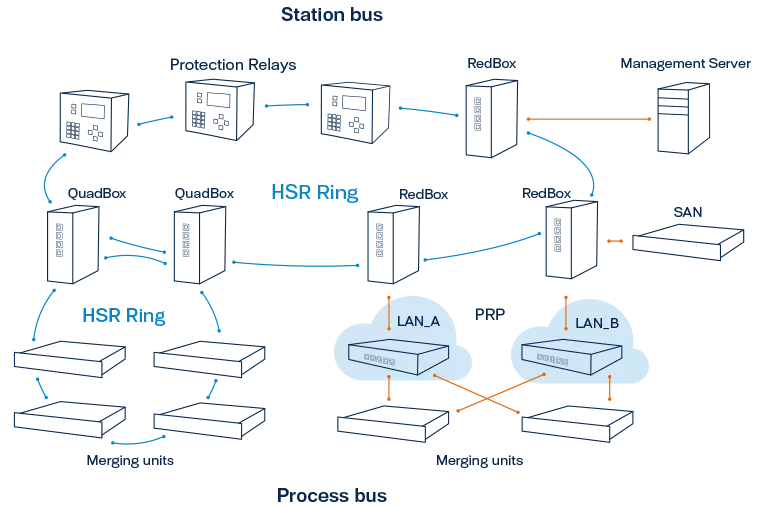Introduction
Flexibilis Redundant Switch (FRS) is an IP core providing HSR/PRP functionality. Thanks to its scalability, the single IP core can be used in both low- and high-end FPGA-based devices. FRS has been validated using methods such as hardware accelerated simulation to guarantee the quality of the IP. HSR is proven in use for applications in energy management (smart grid), industrial automation and transportation.
Features
- Can be configured as a 3- to 8-port layer 2 Ethernet switch
- All ports are triple-speed (10 Mbit/s / 100 Mbit/s / 1 Gbit/s)
- Internal wire-speed forwarding capability (gigabit Full-Duplex at all the ports at the same time)
- Integral PTP support for applications where time synchronization is needed
- Includes transparent end-to-end clock between ring ports
- Peer-to-peer transparent clock possible with control software (e.g. XR7 PTP) running on an attached CPU
- Achieves nanosecond class accuracy in clock transfer when using Gigabit fiber Ethernet
Technologies
High-availability Seamless Redundancy (HSR) is a standard (IEC 62439-3 Clause 5) fulfilling the need for reliable Ethernet. It is suitable for applications that require short reaction times and high availability. With HSR, a network can be made very robust with zero reaction time in case of a single failure, with predictable latency and with less cost than with other Ethernet redundancy solutions.
Many critical applications require a network with zero downtime. The network is fully operational even during maintenance, as any device can be disconnected and replaced without breaking the network connectivity. This makes the network very reliable and highly available.
Find out more on our technology page.
The Parallel Redundancy Protocol (PRP) is an IEC standard (IEC 62439-3 Clause 4) providing redundant Ethernet. Under PRP, each node is connected to two separate parallel LANs, parallel Local Area Networks (LANs). Source nodes send two copies of each packet, one over each network. When a destination node receives a packet, it accepts the first copy and discards the second copy, eliminating the duplicate.
HSR is more cost-effective than PRP because HSR requires significantly less cabling. Therefore, HSR can be considered the most effective redundancy solution available for Ethernet at the moment.
Find out more on our technology page.
Configuration
FRS is highly configurable. For example, a 4-port FRS can be used to implement End Nodes and RedBoxes. Typically one of the Ethernet interfaces is internal, for the device internal CPU to be able to access the network. Two external Ethernet interfaces connect to the HSR ring and the fourth interface is an interlink port. At least a 4-port FRS is recommended, as then no separate RedBoxes are needed and the devices can be connected straight to the FRS.

Example of a redundant network using HSR
Technical Specifications
Ports |
3 to 8 ports; 10/100/1000 Mbit/s |
|---|---|
Physical Interfaces |
MII, GMII RGMII, SGMII, RMII, 100BASE-FX, 1000BASE-X Avalon slave interface for management register access |
HSR |
HSR RedBox, HSR End Node, HSR-PRP RedBox and QuadBox support |
PRP |
PRP RedBox and DANP support |
IEEE 802.1Q |
Port-based VLANs and VLAN tagging Prioritization of packets on egress ports Untagging of VLAN frames on egress ports |
Clock Synchronization |
IEEE 1588-2008 layer 2 one-step end-to-end and peer-to-peer transparent clock support |
Switching Engine |
Cut-through and store and forward operation 4096 VLANs 16 MAC address filters per port 4096 entries for MAC address learning Up to 4096 policer per port (optional) 8 traffic shapers per port (optional) Up to 16k static configuration of MAC addresses (optional extra) |
Statistics |
Detailed packet statistics counter |